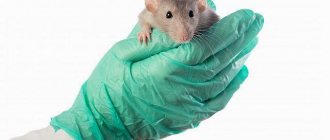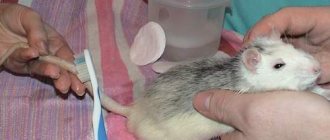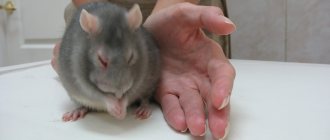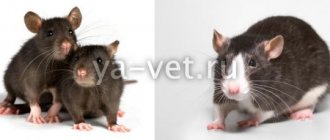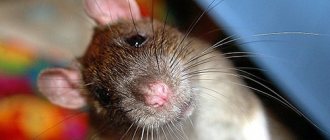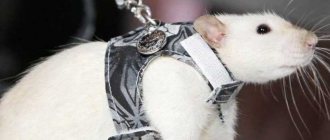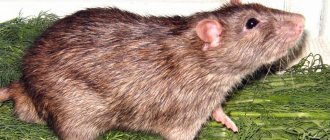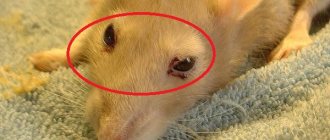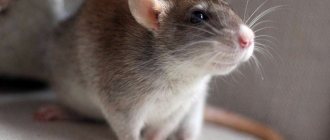In addition, such uncontrolled destruction of mice and rats on our own has two options for an unfavorable outcome.
- Firstly, there is a risk of poisoning pets and homeowners themselves with rat poison;
- Secondly, most often these measures are ineffective, but they become addictive to rodents, which complicates further professional deratization and increases the costs of its implementation.
To finally solve this problem and get rid of the rodent infestation, you should not neglect the services of professional employees with experience in deratization of premises. The specialists of the Operational Pest Control Service have enough experience and carry out deratization to exterminate rats with a 100% guarantee. They successfully cope with their task in conditions of any degree of complexity, regardless of planning conditions, size of area, intensity of rodent colonization of the adjacent territory and other objective factors.
Causes of colds
Decorative rats are bred specifically to live in an artificial environment near humans. Compared to their wild ancestors, their immunity is much weaker. Therefore, they often suffer from respiratory diseases, the pathogens of which enter their body from a sick person. Therefore, if there is a sick person in the house, the rat must be quarantined. If this is not possible, then contact with the patient should be reduced as much as possible; the animal should be fed and watered while wearing a protective mask.
Most often, cold infections are recorded in the cold season (from October to March). Infection is also facilitated by a decrease in fresh greens in the diet. These products contain vitamins, minerals, and other biologically active components that stimulate the animal’s body’s defenses.
Another negative factor operating during this period is the operation of heating devices, which contributes to drying out the air. Breathing such air leads to drying out of the mucous membranes of the nasopharynx. And this means a significant decrease in local immunity, since the mucus secreted by the epithelium contains a large amount of interferons and antibodies.
Infection with cold pathogens is also facilitated by:
- keeping in a drafty room, but lack of ventilation can also provoke illness;
- hypothermia;
- insufficient or poor quality nutrition;
- deficiency in food of vitamins (especially A and C), minerals;
- excessive dampness or dry air.
Due to exposure to one or more of these factors, the body's defense system is further weakened and loses its ability to quickly neutralize pathogens. As a result, the pathogen that has penetrated the upper respiratory tract has the opportunity to multiply and cause illness. The most common causes are streptobacilli, pneumonia bacilli and diplococci.
Professional deratization of premises
In solving this problem, it is quite possible to rely on the professional services of the Operational Pest Control Service, whose employees operate throughout Rostov-on-Don and in adjacent settlements.
The personal experience of each of the specialists, modern equipment and knowledge of professional technology are complemented here by the use of exclusively certified products for deratization of premises with a valid shelf life and 100% effectiveness of use.
The combination of all these factors ensures the complete extermination of mice, rats and other rodents to a single individual. Both adult representatives of the colony and recently born rodents are subject to destruction - professional technology works flawlessly along with effective means of fighting rats, regardless of how securely the rodents are hiding.
If you need additional information about the services of the Operational Disinfestation Service or if you intend to call a pest control team, please contact customer support at the phone number indicated on this catalog page.
Symptoms of the disease
The main signs that your pet has a cold include the following:
- loss of appetite or complete refusal to eat;
- apathy and lethargy;
- refusal to brush wool;
- dullness and ruffled fur;
- causeless aggression, nervousness, increased excitability;
- mucous or mucopurulent discharge from the nose and eyes;
- cough, sneezing, runny nose.
If you notice the first symptoms of the disease, for example, sneezing or refusal to eat, the animal should be taken to the veterinarian immediately. If the cold develops into pneumonia, the rat will live no more than four days.
It is important to remember that only a qualified veterinarian can make an accurate diagnosis and prescribe effective treatment. Any attempts at self-medication will most likely end in failure and lead to the death of the animal.
Diseases of domestic rats
Veterinary center
Rodents
Breeds of decorative rats
Diseases
Ratologists are confident that proper maintenance will protect the rats you keep at home from getting sick. And the rules are simple: hygiene, comfortable maintenance, care, balanced nutrition and periodic consultation with a veterinarian.
Diseases in domestic rats are, unfortunately, very common. The fact is that these animals received from their wild ancestors a very unstable nervous system, and, consequently, problems with immunity. Their genes are subject to rapid mutation. So allergies and parasites - these diseases of domestic rats can happen even to those pets for whom the strictest and most vigilant care is provided.
Diseases of rats. Symptoms
What do domestic rats suffer from? Let's pay attention to the most common diseases of domestic rats and their treatment.
Mycoplasmosis
The culprit of this disease is the bacteria Mycoplasma pulmonis. All rats can be carriers of these bacteria, but those animals that get sick are those that were in direct contact with a sick rat, or have weakened immunity due to advanced age or poor care. Signs of a rat's illness: wheezing, nasal discharge that looks like blood, frequent sneezing, choking.
This disease affects the rodent's lungs, and in females the uterus may be infected. If the disease is just beginning and the veterinarian has identified it at an early stage, Tseprolet will be effective. If a young rodent with a weakened immune system falls ill with mycoplasmosis, it would be appropriate to treat rats with cephalexin - “Cephalysin”, “Tseporin”, “Cephalexin”... The medicinal echinacea can enhance the effect of antibiotics and also help the rodent’s body fight the infection.
If the rat is old, then the pattern may be different. Then treating the rat with Doxycycline will be the most reasonable (if the disease in the rat has become chronic and the infection begins to affect the lungs, Enrofloxacin (Baytril) or Doxycycline is used.)
Only a rat veterinarian can determine how to treat your rodent.
Listeriosis
Listeriosis is a dangerous disease that can affect humans. Infection occurs through contact with a sick animal, as well as through food that sick animals may have eaten. This disease has acute, subacute and chronic stages. The first thing that catches your eye is that the rat got sick and stopped eating on its own. Against this background, the rat’s body temperature rises and its balance is disturbed. In females, the uterus is affected and cannot bear young.
If the disease passes in the acute phase, the animal dies within two days. It also happens that no visible symptoms are observed, but the animal is contagious. His condition can only be judged after laboratory tests.
Unfortunately, all sick animals have to be euthanized. The remaining animals are quarantined, identifying those who are sick. After contact with sick animals, you must thoroughly disinfect your hands. Because the disease is also dangerous for humans.
Ectromelia
(mouse pox)
A disease that occurs in acute or chronic form. In its acute form, the disease does not even have time to manifest itself; the rat dies in 90% of cases. The chronic form is characterized by damage to the skin and muscles of the limbs. The culprit is a virus that multiplies in the cells of the skin, spleen, liver and other organs.
Damaged skin becomes covered with many ulcers, and tissue swelling occurs. The chronic form of ectromelia can last for months, and animals that have suffered this infection acquire strong immunity.
Disease prevention - quarantine of newly acquired animals, periodic disinfection of cages and equipment, daily steaming of feed, personal hygiene, etc. Sick animals should be burned after killing.
The virus is most quickly neutralized by a 2% formaldehyde solution. Quarantine - 30 days.
Infectious diseases
Decorative rats are extremely susceptible to infection by microbes and viruses. Anything can be dangerous for them: contaminated food, insect bites, contact with sick animals. Only a veterinarian can determine whether an animal is sick, so if you need a ratologist for a St. Petersburg rat, contact our Profivet clinic.
You will not be able to cure the animal on your own. However, every owner should know and be able to recognize diseases of ornamental rats, as well as observe disease prevention so as not to become infected themselves.
Paratyphoid
, or salmonellosis.
Microbes enter the animal through food and water, and are excreted in urine and feces. As a rule, animals get sick during the warm season. In case of an acute illness, the animal begins to have diarrhea, the excrement has a yellowish color and a pungent odor. The rat's stomach swells due to gases. Paratyphoid microbes are killed by all disinfecting solutions and boiling.
Sick animals are killed, those who came into contact with the patient are left in quarantine for 20 days.
Disinfection of cells and equipment is carried out with a 5% creolin emulsion, a 5% solution of carbolic acid, 1-2% formaldehyde or a 20% suspension of freshly slaked lime. 4-6 hours after disinfection, the cage and equipment are washed under the tap with hot water with or without soap and dried, after which it is again ready to be inhabited by animals.
Pasteurellosis
The cause is bacteria from the genus Pasteurella. Manifest in chronic form: pneumonia, pleuropneumonia, abscesses, subacute - bronchopneumonia, and acute - septic phenomena and hemorrhagic inflammatory processes. The danger of this infection is that other pets can become infected from rats.
Mucus from a rat's nose is contagious, which is why this disease is also called infectious rhinitis. The runny nose becomes purulent, and crusts form near the nostrils. In severe cases, the eyes become inflamed and ulcers form under the skin. This condition lasts only 2-3 days and the animal dies.
The chronic form of the disease has other names - infectious rhinitis, a contagious runny nose, accompanied by profuse serous and mucous discharge from the nose. Subsequently, nasal discharge becomes purulent, and dry crusts form around the nostrils, preventing normal breathing.
Very often the disease is complicated by inflammatory processes in the eyes, subcutaneous abscesses in various parts of the body, etc. The subacute form of the disease lasts 2-3 days and more often ends in the death of the animal. In this case, the temperature rises to 4C, the lungs and intestines are damaged, and the animals are in a depressed state.
In the fight against the disease, general veterinary preventive measures are mainly used: sick animals are killed, animals that have been in contact with patients are isolated and quarantined, general cleaning and disinfection of cages and equipment are carried out. In the chronic form, animals are administered penicillin intramuscularly 3 times a day, up to 2000 units. for a week, and externally, for the treatment of wounds, penicillin ointment.
Infectious pneumonia
White rats are most often affected by this disease. Any rat doctor will tell you that the cause of the disease is viruses that lead to inflammation of the lung tissue and upper respiratory tract.
It’s quite easy to notice that something wrong is going on with the animal. The rat is sick and is not eating well. They are usually inactive, disheveled, and breathing heavily and heavily. Purulent discharge is visible from the nose and eyes. The acute form of the disease ends in death after 3-4 days.
But the chronic form can end happily for the animal. After two weeks, such an animal recovers. Dead animals are destroyed, and quarantine for contacted animals is introduced for 20 days.
The disease can occur in acute and chronic forms. Sick animals are inactive, hunched over, cough, refuse to feed, their fur is disheveled, breathing is rapid and labored, serous-mucous discharge from the nose and purulent discharge from the eyes are observed.
The duration of the disease in the acute form, which often ends in the death of the animal, is 3-4 days, in the chronic form it is protracted: in most cases, recovery occurs in 12-15 days.
Since infectious pneumonia is extremely contagious and causes high mortality, it is better to destroy sick animals. All individuals that have been in contact with a sick animal must be immediately transplanted into other cages, and the previous cage and the place in which it stood must be disinfected. Quarantine - 20 days.
(Read about other diseases in the article “Diseases of rats and their treatment”)
What to do if your rat gets sick?
It must be remembered that, contrary to the optimists who love pet rats who write on the Internet that rodent diseases are not dangerous for people, this is not the case. For example, tularemia is a very dangerous and highly contagious disease. It can not only kill a rodent, but also infect other domestic animals: cats, dogs, as well as the owner himself. Infection is transmitted through mucous membranes, and also through the bite of a mosquito or tick. So, if you need rat treatment in Moscow, contact our Profivet clinic.
It is equally important to maintain personal hygiene and protect other pets and household members from sick animals. The good news is that many serious diseases can be controlled by treating rats with antibiotics. But it is important to remember that self-treatment can be very dangerous for the life of a rodent. For example, giving penicillin antibiotics to rats is strictly prohibited; they can cause the death of the rodent and cause anaphylactic shock.
As with people, self-medication is not allowed with rats.
We wish you and your furry pets health!
How to treat a pet at home
Without the appointment of a specialist, the rat should not be treated independently or given medications. But there are a number of actions that the owner can take independently, including:
- Ensuring complete peace and optimal living conditions.
- Limiting physical activity (walking, training, active games should be avoided).
- The cage must be moved to a warm room without drafts. It is advisable to measure the air humidity, and if it is insufficient, install a humidifier. If it is not available, you can place wet towels on the batteries.
For respiratory tract infections, doctors often prescribe antibacterial drugs (Tylosin, Azithromycin, Doxycycline). If the disease becomes chronic, they are replaced with more powerful ones, and corticosteroid hormones are added to the treatment regimen. Therefore, it is important to seek qualified help as early as possible.
In elderly and weakened pets, these drugs may not have the desired effect. In such cases, Doxycycline or Enrofloxacin is prescribed in high dosages, sometimes in tandem. The veterinarian determines the treatment regimen individually, depending on the characteristics of the sick animal’s body.
If therapy does not produce the desired results, inhalations with gentamicin and albuterol are used. Hormonal drugs (dexamethasone, prednisolone) are also added. They are used especially often if the inflammatory process has reached the lungs.
It is impossible to change anything in the regimen prescribed by the veterinarian; any changes in dosage or duration of treatment are possible only after consulting a specialist. Often, animal owners have a negative attitude towards the prescription of gentamicin and chloramphenicol. But in advanced and complicated situations, it is unlikely that it will be possible to save the animal’s life without these drugs.
What can you do if a decorative rat falls from a height?
Rats are extremely agile animals, which allows them to keep their bones intact even when they fall. However, the reflexes that force a decorative rat to land on all four paws at the same time are powerless when falling from a great height. If the pet lies motionless on the floor, then most likely he is in shock from such a jump. In this case, only time and complete rest can help.
Prevention
To reduce the likelihood of a cold in your pet rat, follow these recommendations:
- The pet's cage or house should be kept in a warm place, well protected from drafts.
- It is necessary to monitor air humidity and adjust it if significant deviations occur.
- Avoid walking during the cold season.
- If there are drafts in the room, do not let the rat fall on the floor.
- Carefully monitor nutritional balance and food quality.
- As a preventative measure, sprouted cereal seeds (wheat, oats) should be given in the autumn-winter period.
- Avoid contact of the animal with sick people or other pets.
Remember that proper nutrition and optimal living conditions help strengthen the immune system. This is the key to good health for the rat, since its body will be able to cope with most infections on its own.
The health of the rodent is primarily the responsibility of the owner. It is important not only to create good living conditions for the “little friend”, but also to carefully monitor his condition. If the slightest sign of illness occurs, you need to show it to a competent specialist.
How long do decorative rats live and why you shouldn’t trust rodent sellers
Sometimes you can hear from experienced breeders of decorative rats that these animals, with proper care, can easily cross the seven-year age limit. Unfortunately, the reality is not so rosy, since rats are susceptible to many pathologies that have a negative impact on their health and thereby significantly reduce their life expectancy.
Decorative rats live from 2 to 3 years
Consultants in pet stores recommend decorative rats as extremely hardy and unpretentious animals. In fact, this statement is from the evil one. Veterinary science says that rats, like other pets, can have a variety of health problems. In addition, without timely help, some pathologies can kill the animal.
Decorative rats get sick very often
Parasitic diseases: symptoms and treatment
The development of parasitic diseases in rodents is caused by the activity of external or internal parasites. With timely treatment they have a favorable prognosis. Infection, as a rule, occurs through the consumption of low-quality food or improper maintenance of decorative rats.
Ticks
They stick to warm areas of the body with the most intense blood supply - ears, neck, groin area, skin folds. It is impossible to visually detect blood-sucking parasites on the body of an animal.
The only exception is that if mites have attached themselves to the ears, the edges of the ears will be lumpy and uneven. The following symptoms may indirectly indicate the presence of bloodsuckers:
- scabies;
- the appearance of wounds on the body;
- pet irritability;
- sleep problems.
A veterinarian will make an accurate diagnosis. For treatment, specialized drugs are used, for example, Stronghold drops, Dironet Spot-on, Parasiticide-complex.
Lice and lice eaters
Small insects 0.5-3 mm in size. Lice feed on the blood of warm-blooded animals. The food for lice eaters is mainly dead cells of the dermis and sebum.
Female insects of both species lay nits in the host's fur, gluing the eggs with a special sticky liquid. It is impossible to see an adult insect with the naked eye. Symptoms of small insects include:
- deterioration of the animal's mood;
- nervousness;
- presence of nits in wool;
- constant scratching;
- wounds on the skin.
Treatment is carried out with specialized drugs for external parasites - Bars, BioVax, Celandine. Neostomazan is considered an effective drug. The emulsion is diluted with warm water and the resulting solution is rubbed on the fluffy’s body. After that, wrap the animal in a towel for 5-7 minutes. After the specified time has passed, the rodent’s fur is dried with a hairdryer.
Helminths
The eggs of parasitic worms enter the rat's body most often through dirty water or raw vegetables and fruits. Severe pathological symptoms with helminthiasis are usually absent. Indirect signs of the disease include:
- deterioration of the pet's mood;
- weight loss;
- change in stool - the appearance of constipation or, conversely, diarrhea.
Helminths are easily removed from the body of rats using specialized drugs. For example, Dirofen, Shustrik, Nemozol. The listed funds are used not only for the treatment, but also for the prevention of helminthiases.
Why did the decorative rat begin to lose weight with age?
The owner of a decorative rat must be ready to care for his elderly pet. Older animals change in appearance and behavior, which forces the owner to treat them in a special way. The once active decorative rat suddenly becomes calm and begins to lose weight. The fur loses its former luster. Vision also loses its sharpness, up to complete blindness. At such a moment, only the owner can help his pet remain happy, even in spite of old age.
How to determine if there are rats in the house
You can make sure that there are unwanted guests on the territory for several reasons:
- frequent traces of excrement;
- damaged containers and packaging where food is stored;
- paw and tail prints on dusty surfaces;
- presence of ammonia odor;
- rodent corpses.
Two incisor marks on various objects are the first sign of the presence of rats in the house. You can track the habitat of rodents by following their tracks and carefully studying where they lead. Along the way, rats often stick to different objects, and thus leave dark spots behind them. It is along them that you can walk and track where the rats have settled. The smell of ammonia is the first call that should awaken you to action and start the fight without delay!
What measures should be taken afterwards to avoid a re-invasion?
Treat all surfaces with a special compound after treatment a week later; Follow a set of preventive measures. It is advisable to leave the poison for another week after removal. Use ultrasonic repellers, ensure regular garbage removal, and clear favorite habitats (attics, basements, garages) of trash. Such preventive measures will allow you to protect your home from re-entry and maintain sanitary cleanliness in your area. However, if tailed animals reappear, you should contact the city service, which is responsible for elimination and extermination. You can call a specialist by phone.
Fighting rats at the dacha in Rostov-on-Don
With the arrival of a cold cyclone, the rats look for shelter for the winter. This is a very important aspect! Therefore, it is advisable to increase vigilance and control at this time of year. If at least one individual is detected on the territory, it is necessary to take appropriate measures. Methods of fighting in the country can be very radical, but at the same time highly effective. It is advisable to carry out a complex for the destruction of rodents together with the special services. Professionals know the habits of pests, and with the help of special-purpose devices they will eliminate pests in a short time and for a long time.
Fighting rats in a private house in Rostov-on-Don
Rats should not be underestimated. These are very savvy pests. For example, if one individual falls into a trap, then others will already avoid this place. Therefore, before you start fighting rats on your territory, you first need to think carefully about everything and develop a strategy. Traps should be installed in places where rodent traffic is high, as well as near places that can be lured by food odors. As soon as the rat tries to get to the food, the trap will certainly work. This method can be used several times, but not constantly. Rats are quite smart and will avoid a place that poses a danger to them. Today the market can offer traps that do not injure rodents. They will eliminate the terrible sight of seeing a dead rat, and subsequently the need to contact it. There are special cages where the rodent ends up permanently. An effective tandem can be a poison bait that leads directly to the cage. Having eaten the bait on the way to the cage, the rat dies directly in it. An alternative to this method is the use of electric traps, where the animal dies from an electric discharge.
Physical methods of rat control in Rostov-on-Don
This method involves blocking holes and exits. Barriers are placed for rats on the way to food products and the rodent, having no food and no way out, dies in its own burrows. It is advisable not to use this method at home, as hungry rats will make heart-rending sounds. The time for physical death cannot be determined, since they may have food reserves in their burrows. It is also worth noting that it is not known when the rat died and it is impossible to determine the time to prevent the corpse from decomposing indoors. If this time interval is missed, then the whole house will be filled with a terrible putrid smell.
How long does the rat extermination procedure take?
In a private home it lasts several hours. To do this, rodent pest control specialists release a special gas into the house, which kills and leaves for several hours. This trick will be better if you simultaneously pour poison into the holes through which they crawl, so that no one can escape. Afterwards, the room is ventilated. In an apartment or other enclosed spaces, you can fight with other methods, for example, blowing a drug (foam with poison) into the holes. Trying to get through, she gnaws on the hardened foam and becomes poisoned. This method will help get rid of unwanted guests in a few days.
What method of exterminating rats is considered the most effective?
The most effective home defense system is the use of poison and setting traps. You can buy the substance in any specialized store or order it online. The poison kills instantly. If you don't know how to use it, you can find a sample on the Internet. It is also possible for an earthen species (or another name for it, a vole) to fall into the traps; the main thing is to move them to new places. Ultrasonic electrical devices are good at scaring away uninvited visitors. Ultrasound has an irritating effect on them. Remember that only comprehensive measures will help achieve the desired result.
